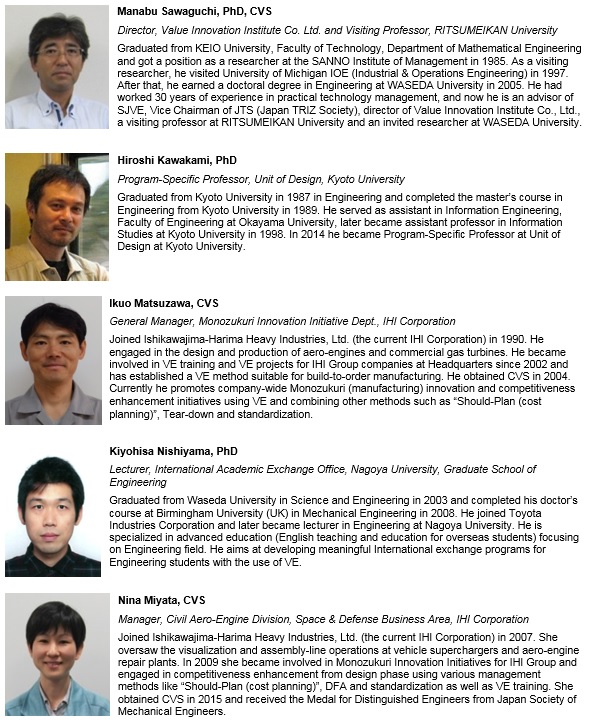By Manabu Sawaguchu, PhD, CVS; Hiroshi Kawakami, PhD; Ikuo Matsuzawa, CVS; Kiyohisa Nishiyama, PhD; Nina Miyata, CVS
In relation to this paper, SJVE has prepared two online survey questionnaires on “Innovation activities for Value Engineer”. We appreciate your response and input if you are interested in the subject.
Below are the links to these web pages:
Innovation activities for Value Engineer
Innovation activities for Value Engineer (Part II)
Concept of Fubeneki and Objective of this Study
The discussion of Fubeneki (literally, “benefit of inconvenience”) in this paper should presuppose that “inconvenience” should generally mean “requiring a lot of work” in physical terms and “consuming cognitive resources” in psychological terms. Works prone to consume cognitive resources include judgment, decisions, detailed work, difficult work and unfamiliar work among others. On the other hand, “convenience”, which means “being not inconvenient”, should be used with the meaning limited to “saving time and effort”. Under such premises, Fubeneki may be defined as “utility (usefulness) obtained because something physically requires a lot of work or psychologically consumes cognitive resources”. This concept is related to subjective views of individuals, such as the sense of achievement. On the other hand, use function, which is dealt with in VE, pursues convenience (reduction of required work, etc.) and, according to the authors’ intuition, it faces the complete opposite direction of Fubeneki. Aesthetic function, which is also dealt with in VE, may be conceived to be a concept relatively close to Fubeneki, as it pertains to Kansei (sensibility), such as likes and dislikes about design or other things. However, while aesthetic function should not interfere with use function; in order to realize Fubeneki, use function should be aggressively obstructed. Considering the positioning described above, at a glance, it seems that Fubeneki is not compatible with VE. Nevertheless, this paper attempts to develop and propose the next generation VE (value engineering)/VM (value methodology) encompassing a new concept and technique of value improvement by the introduction of Fubeneki-Function (described later) based on the achievements and future prospects of “Fubeneki & VE Study Group”.
Positioning of use function and aesthetic function in VE
VE is often applied to industrial products, which vary widely from consumer goods to producer goods. The major function of industrial products is the “use function”, which is directly linked to the purpose of use. However, the “aesthetic function”, which is related to creativity and aesthetic appearance that would make customers feel like owning the product, is also incorporated into the design of products, such as consumer durables. Therefore, two types of functions, namely, the use function and the aesthetic function, are the subject of VE. On the other hand, according to the definitions of VE, “necessary function” is a “function desired by customers” [1]. As such, it may be interpreted that use function as desired by the target customer is determined by whether or not it is “necessary” for the target customer and that aesthetic function is determined by whether or not it is “liked” by the target customer (see Fig. 1).
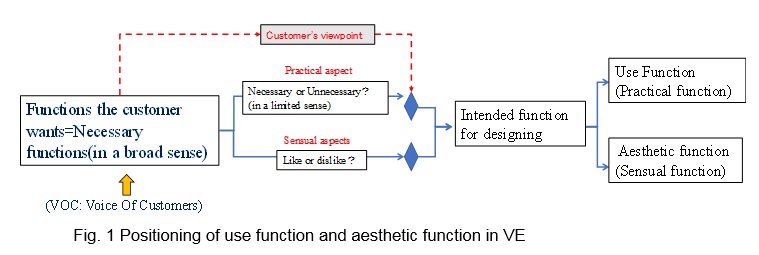
Since the use function of the product is a practical function, it is considered that, judging from a long-term perspective, “pursuit of convenience (increasing Benrieki (literally, “benefit of convenience”): see Fig. 5) through multiple functions (increasing necessary use functions) and/or higher functionality (enhancement of necessary functions)” will be the focus of corporate activities. As a result, products (systems) will take the place of humans to realize use functions, which will lead to the progress of automation. This is the strategy of regarding work as something negative and promoting technological development in order to eliminate it. During the period of high economic growth, such a product development strategy must be taken for granted. However, as the human-machine system is now recognized as an academic discipline, and the term “interaction design” was coined in the 1980s, in the area that essentially deals with the influence of humans on systems, it is not enough just to pursue automation or the improvement of efficiency.
For example, while automation (which is a convenient means to improve efficiency) is often adopted, it has been pointed out, that long-time use of auto pilot features will lower the ability of the pilot [2]. Also, in 1988, The Psychology of Everyday Things was released by Donald A. Norman, in which he described the essence of human centered design (the attitude of designers always considering the actual incidence of errors that are likely to occur to design products in a way to minimize the impact of the occurrence of such errors) [3]. As such, it is certain that now is the time when product evolution by harmonization between humans and products (“evolution by rhythm harmonization with humans” in TRIZ [4]) as well as improvements in efficiency by encouraging multiple functionality and high functionality is being considered.
However, such thought is encompassed by the “principle of user priority”, which is one of the five principles of VE. Accordingly, it can be covered by the traditional methodology of VE. Also, in today’s society in which the service industry flourishes in accordance with the advent of the era of user experience of events (services) in place of the era of usability (easiness of use) of things (products), the principles of “user priority” and “functional orientation” remain unchanged in VE and are within the traditional territory of VE. In other words, from the VE perspective, the design theory described above aims to achieve optimization while considering the balance between user function and aesthetic function and to avoid deviation from the essence of human centered design. As such, the “next generation VE/VM” to be proposed by this paper may be expected to serve as a candidate of a “new axis (=unique design theory)”, which is not covered by current major design theories.
Proposal of Fubeneki-Function as the third function
1) Benrigai and Fubeneki-Function
The design theory described in the previous chapter sounds an alarm on unilinear multiple functionality and high functionality by referring to the “Benrigai (literally, “harm of convenience”)” phenomena, such as the lowering of human ability caused by excessive automation, but it does not go so far as to imply the emergence of Fubeneki-Function, which lies ahead. As such, this paper redefines “Benrigai” and “Fubeneki-Function” and realizes “Fubeneki” (see Chapter 1)”, is on the opposite pole of “Benrigai” (see Fig. 2).
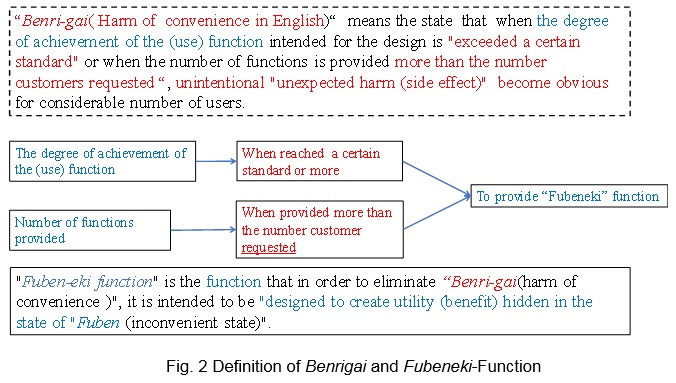
2) Empirical law obtained from an example of Fubeneki product
A “Prime number ruler” is a Fubeneki product developed by Kawakami and others. Kawakami, who is one of the authors of this paper, created the idea of this product through brainstorming with his students at Kyoto University. The idea was actually commercialized and the product was put to market, covered by the media and became a hit product [5]. Fig. 3 shows the outline and the photo of the product. Kawakami and his students have also collected more than 100 cases of inconvenience that provide utility because of their inconvenience. These examples include those that do not seem to be relevant to VE on the surface, such as: “Because of the breakdown of my motorcycle, I had no choice but walk to the university,(which was inconvenient;) but that led me to drop in at a restaurant which I had not noticed in the past, and, now, it is one of my favorite restaurants”. However, this example, can be abstracted to “an inconvenience of having to adjust actions in order to seek continuity (which takes time), increases the chance of awareness”. The abstracted description may be applied to many cases. As a result of an analysis, these cases were systematically integrated into “12 inconveniences that are likely to bring benefits” and “8 benefits that are likely to be obtained from inconvenience” (see Table 1 below).
Details of this analysis are described in a separate report [6]. Also, their effectiveness as a tool to support divergent thinking has been verified by using them as a card-type idea generation support tool (see Fig. 6) [6]

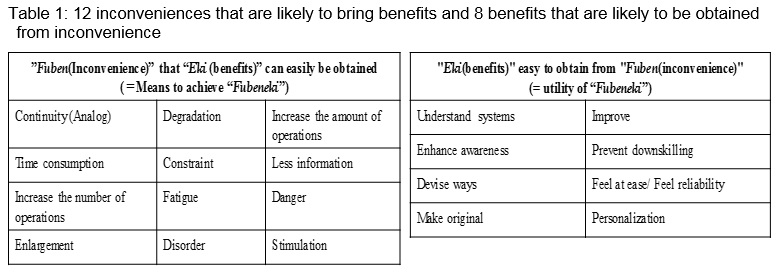
3) Difference between the realization of Fubeneki-Function and the Use Function
The Fubeneki-Function is a function that realizes the utility of inconvenience and use function is a function that realizes the utility of convenience (=improved efficiency). As such, Fubeneki-Function directly corresponds to the “8 benefits that are likely to be obtained from inconvenience (right side of Table 1)” and by converting these benefits to functional expressions, “high-level Fubeneki-Functions” can be obtained. Also, the “12 inconveniences that are likely to bring benefits (left side of Table 1) may also become “low-level Fubeneki-Functions” when they are converted to functional expressions. Moreover, by reorganizing them according to the “purpose -means” logic, a proto version of the Fubeneki-Functional tree diagram (see Fig. 4) can be created.
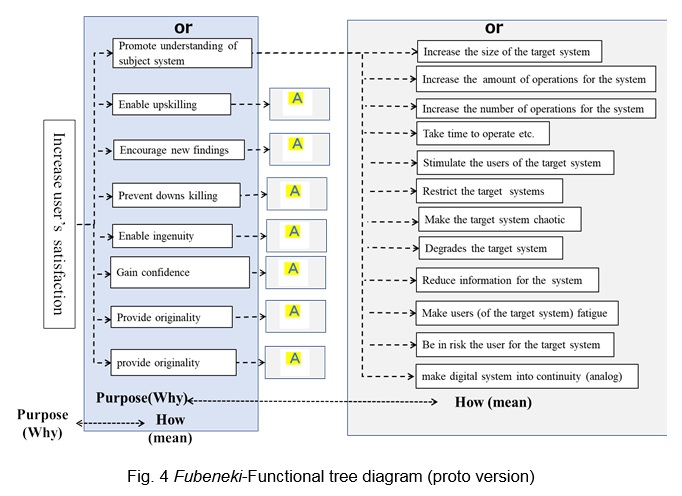
If the highest-level function in this tree diagram is expressed as “Improve user satisfaction”, all the Fubeneki-Functions, which are the means to achieve this, will have an “OR” logical relationship with the higher-level functions. In other words, the highest-level function can be achieved by achieving one or more Fubeneki-Functions. The number of Fubeneki-Functions to be achieved will depend on the subjective view (personality and characteristics) of the target customer (or user). It is intuitively evident that “inconvenience” and “improved efficiency (utility of convenience)” resulting from the realization of use function are not compatible with each other. However, it does not mean that they face the opposite directions on the same evaluation axis. In other words, they do not completely contradict with each other. In fact, while the utility obtained from inconvenience (8 inconveniences in the right side of Table 2), which was referred to in the previous paragraph, is difficult to evaluate quantitatively, quantitative evaluation is generally preferred for efficiency and use value. Here, it is assumed that they are independent from each other, regarding the former (Fubeneki value) as a qualitative value and the latter (use value) as a quantitative value. Fig. 5 is a graphic representation of the concept revolving around the discussion above in connection with the “economic transition” of Japan and the locus of change, that is:
Fubengai → Benrieki→ Benrigai →Fubeneki.
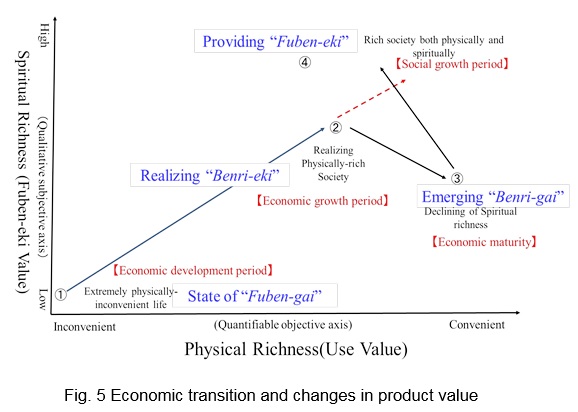
Functional Analysis technique with the introduction of the Fubeneki-Function
1) Necessity of the introduction of the Fubeneki-Function
In the traditional VE, use function is in the engineering domain and it is measurable. On the other hand, aesthetic function (creativity system characteristics) is positioned as a complementary function to use function, although it is in the Kansei domain that is difficult to objectify. In other words, provision of aesthetic function is close to an activity in the area of industrial design and it can be quantified to a certain extent by taking the approach of Kansei engineering [7]. Accordingly, it may be interpreted that as a concept, aesthetic value is included in use value and that it is an additive value directed to add to use value. On the other hand, Fubeneki-Function is definitely a qualitative subjective axis (see Fig. 5) and it is similar to aesthetic function on the surface, but it does not have a complementary (subordinate) relationship with use function, nor is it a complete opposite of it. As such, it is determined highly significant to introduce Fubeneki-Function as the third function for the development of the next generation VE/VM. The Use function, and the Aesthetic function are dealt with in VE together with the Fubeneki-Function being introduced are all systematically organized in Fig. 6.
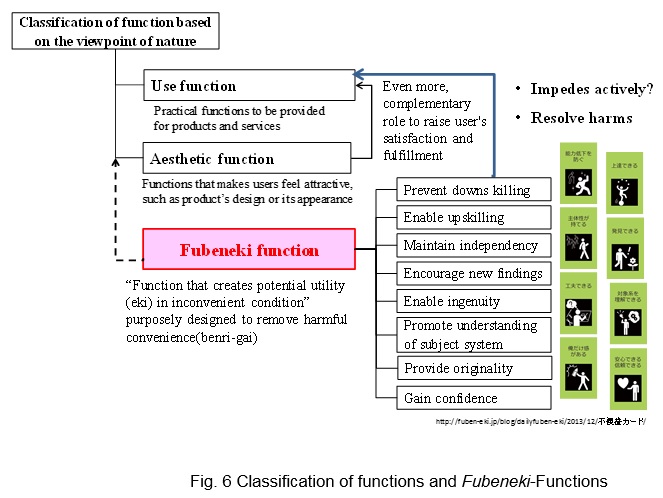
2) Three product idea generation methods correspond to the Fubeneki-Function
(A) Forced association to make existing product inconvenient
This simple method is to forcefully generate ideas to make an existing product inconvenient and then consider the benefits that may be obtained from it. “Prime number ruler (see Fig. 3)” was basically developed in accordance with this method. Another method is to generate ideas by brainstorming based on the “12 inconveniences that are likely to bring benefits (see left side of Table 1).
(B) Development and creation of Fubeneki-Functional diagram from normal functional tree diagram of existing product: function-oriented idea generation (1)
This method is to create a normal functional diagram of an existing product, extract Benrigai from it, define Fubeneki-Functions based on the Benrigai and then, create a Fubeneki-Functional diagram. After that, an appropriate level of Fubeneki-Functions is determined in order to generate ideas from the functional domain.
(C) Creation of Fubeneki-Functional tree diagram based on proto version Fubeneki-Functional diagram: function-oriented idea generation (2)
This method is to directly create a Fubeneki-Functional diagram without creating a normal functional diagram of the target product. Fig. 7 is a Fubeneki-Functional diagram of a measuring spoon created with this method.
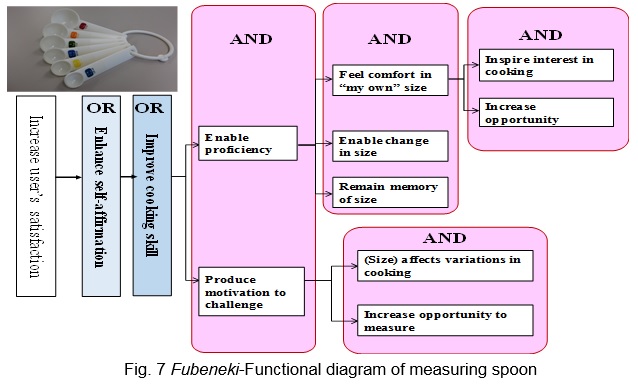
Example of Fubeneki VE
Of the “three product idea generation methods corresponding to Fubeneki-Function” introduced in the previous chapter, the second method is adopted in this paper. The target theme is “seal”, which is a symbol of the culture unique to Japan.
First, a functional tree diagram is created according to the traditional steps to define functions (after confirming the constituent elements of existing seal.) Then, the Fubeneki-Functional diagram is created, based on the functional diagram. Fig. 8 shows the relationship between the normal functional diagram and the Fubeneki-Functional diagram.
In the idea generation stage of this example, a special focus was placed on the Fubeneki-Function “Personalize transcribed information”, which is a direct high-level function of the Fubeneki-Functional tree diagram of seal, to generate ideas. At first, it was attempted to create as many ideas as possible based on divergent thinking through brainstorming by the study group members (five or six of them). After that, the ideas were concretized by repeating convergent thinking and divergent thinking. More specifically, sketches were created for the generated ideas and based on the promising sketches, the ideas, including the possibility of combining multiple ideas, were examined, and finally, the ideas of six Fubeneki products were reached. Based on the design approach, prototyping was immediately started in accordance with these ideas.
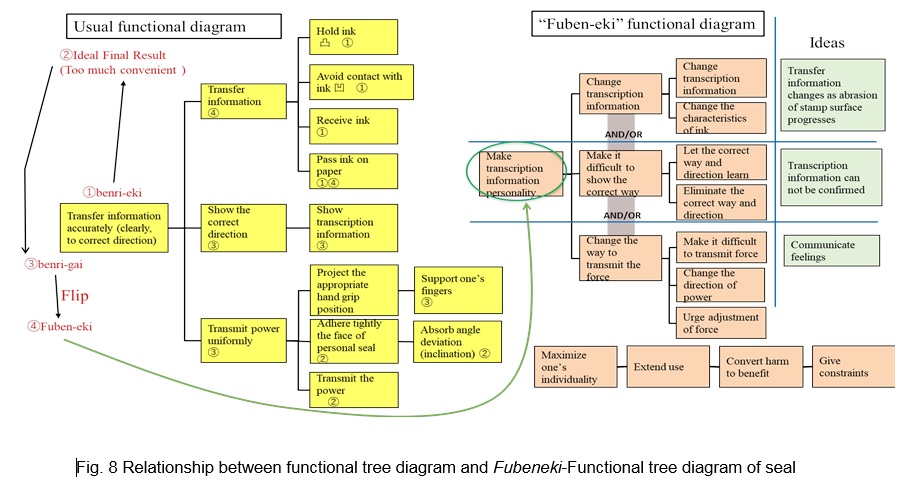
Conclusion
This paper has been written based on the assertion that the Fubeneki-Function proposed by this paper is not either a use function nor an aesthetic function, and that it should be regarded as the third function. More specifically, the assertion consists of the following points:
1) Fubeneki-Function is not a concept contrary to improved efficiency resulting from the realization of use function. It is a “new axis” existing in parallel to use function.
2) In terms of the relationship with the aesthetic function, which is in the same subjective domain; although it is similar to the aesthetic function, as a phenomenon, while the aesthetic function is complementary to the use function, the Fubeneki-Function is independent. In some sense, Benrieki (realization of use function) and Fubeneki (realization of Fubeneki-Function) may be in a state of contradiction with a mixture of convenience and inconvenience.
For example, if artificial intelligence (AI) and the Internet of things (IoT), which may bring the ultimate Benrieki, become a reality at an overwhelming speed, some people may lose the ability to think by themselves. In that case, they may only provide Benrigai. However, those who managed to keep up with the speed may enjoy Fubeneki products and services, utilizing the leisure time that has overwhelmingly increased in consequence. For example, they may indulge themselves spending a lot of time in making original pottery by hand. In other words, such products have a potential to be recognized as Fubeneki products in developed countries with a mature society, including Japan. The authors expect that VE/VM with a focus on the Fubeneki-Function will serve as a unique methodology suitable for developed countries that have reached the social growth period, which the authors perceive as an alias for mature society. The authors wish to continue the study group to conduct more practical case verifications and periodically communicate the study results by presenting research papers at international conferences and other opportunities.
References
[1] Hiroshi Tsuchiya. (1998),”Shin VE no Kihon (New Basic VE in English)”,The SANNO Institute of Management Press, [in Japanese]
[2] Federal Aviation Administration. (2013),” Safety Alert for Operators”, Vol.13002
[3] Don Norman.(1988),”The Psychology Of Everyday Things”, A Member of the Perseus Books Group
[4] Stan Kaplan.(1996), “ An Introduction to TRIZ The Russian Theory of Inventive Problem Solving”, Ideation International Inc.
[5] Kyoto University Gift Shop.(2013), “Kyoto University Merchandise?!”, pp30.-31,Research Activities 20 (http://www.kyoto-u.ac.jp/en/research/international/publications/documents/3-4-12-research-output.pdf#search=%27Prime+ruler%E3%80%81kyoto+university%27 (1/10/2018)
[6] Y.Hasebe,et.al.,(2013),”Card-type tool to support divergent thinking for embodying benefits of inconvenience, pp93-102, Web Intelligence, vol13,
[7] Mitsuo Nagamachi, Anitawati Mohd Lokman,(2010),” Innovations of KANSEI ENGINEERING”, CRC Press
[8] Hiroshi Kawakami, Manabu Sawaguchi, Ikuo Matsuzawa, Xiaolei He,(2016) ”Value Engineering introducing Value of Fubeneki”, pp.10-15, VALUE ENGINEERING, No.294 [ in Japanese]
Biographies
